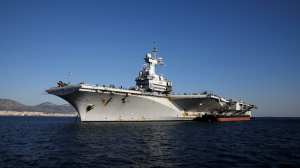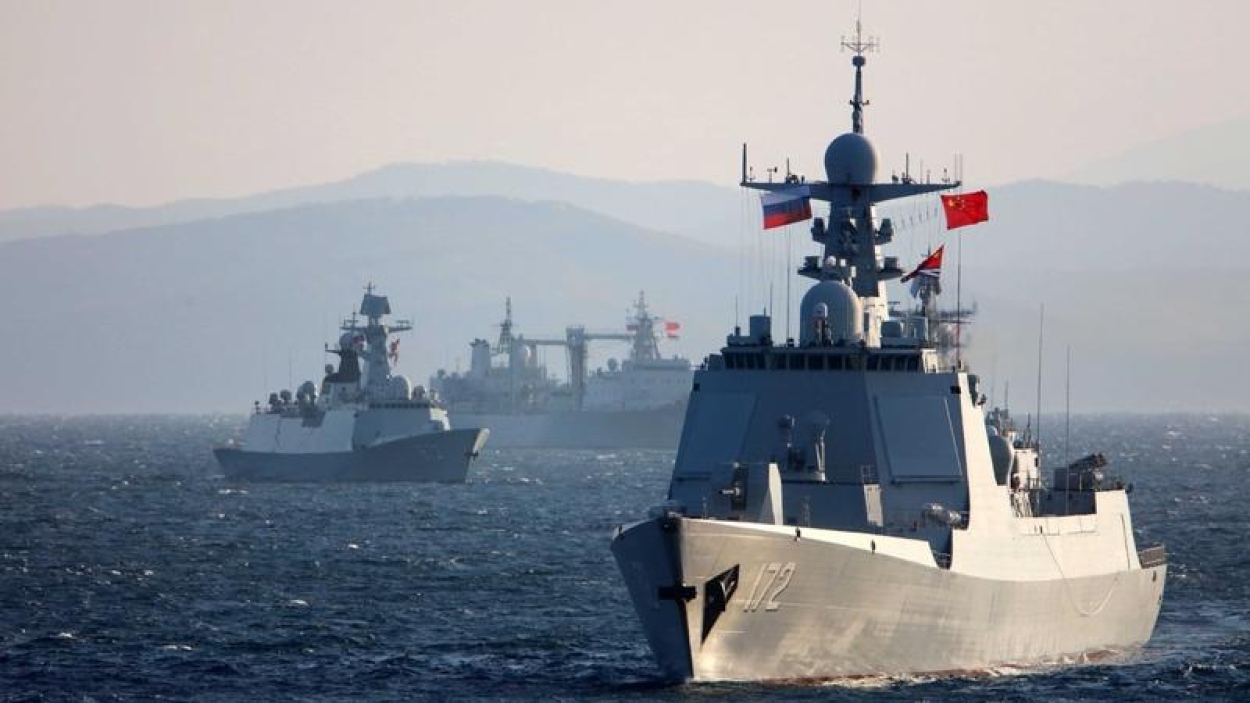It may not be militarily significant that China has deployed its 44th naval escort taskforce for “routine operations” to the Middle East amid rising regional tensions following the conflict between Israel and Hamas. But strategically speaking, it is said to have conveyed a strong message.
The fact that China’s deployment last week took place soon after the US sent a powerful arsenal to the Middle East is being interpreted by the US strategic elites that, more than Russia, China poses fundamental challenges to American power.
Two significant reports on how Communist China (People’s Republic of China or PRC) is continuing its efforts to overturn the international rules-based order and is building an increasingly effective military to further these aims were submitted to the US Congress last week (October 19) so that it would be in a better position to consider the Biden Administration’s proposed military plans, budgets, and programs.
One was the 191-page US Department of Defense (DOD) Report titled “Military and Security Developments Involving the People’s Republic of China, 2023.” The other was the Congressional Research Service (CRS) report of 65 pages, “China Naval Modernization: Implications for U.S. Navy Capabilities—Background and Issues for Congress. Ronald O’Rourke, a specialist in Naval Affairs, authors it.
The DOD report is based on the premise that China is the only competitor of the US with the intent, will, and capability to reshape the international order. It “charts the current course of the PRC’s national, economic, and military strategy” and offers insight into China’s strategy, current capabilities, activities, and future modernization goals.
The report talks of the continued modernization and development of the Chinese military’s capabilities in all fields, including nuclear, space, and cyberspace. The report estimates that the Chinese had over 500 operational nuclear warheads as of May 2023.
China is developing new intercontinental ballistic missiles. These may also be conventionally armed missiles. If designed and fielded, such capabilities would allow the PRC to threaten conventional strikes against targets in the continental United States, Hawaii, and Alaska.

Both the DOD and CRS reports seem to concur on the emergence of China’s Navy as a formidable military force within China’s near-seas region and in the broader waters of the Western Pacific, the Indian Ocean, and waters around Europe.
The DOD report says that the People’s Liberation Army – Navy (PLA-N) has the largest navy in the world numerically, with an overall battle force of over 370 warships and submarines, including more than 140 major surface combatants.
In 2022, the PLA-N launched its third aircraft carrier, CV-18 Fujian. It also commissioned its third YUSHEN class Amphibious Assault Ships (LHA) and has likely begun construction on a fourth as of early 2023.
China also has approximately 60 HOUBEI-class patrol combatants that carry anti-ship cruise missiles (ASCM). The report said that the overall battle force [of China’s navy] is expected to grow to 395 ships by 2025 and 435 ships by 2030.
In contrast, the US Navy is said to have 291 warships, and its FY2024 budget submission projects that the Navy will include 290 battle-force vessels by the end of FY2030.
That means there is now a gap between China’s naval shipbuilding effort and that of the US, and this gap will grow further unless remedial measures are taken.
China’s naval modernization effort encompasses a wide array of ship, aircraft, weapon, and C4ISR (command and control, communications, computers, intelligence, surveillance, and reconnaissance) acquisition programs, as well as improvements in logistics, doctrine, personnel quality, education and training, and exercises.
In the near term, the DOD report says that the PLA-N (the Chinese Navy) will be able to conduct long-range precision strikes against land targets from its submarine and surface combatants using land-attack cruise missiles, notably enhancing China’s power projection capability.
As it is, China continues to challenge foreign military activities in its exclusive economic zone (EEZ) “in a manner inconsistent with the rules of customary international law as reflected in the United Nations Convention on the Law of the Sea.” At the same time, the PLAN conducts activities in the EEZs of other countries, including the United States, Australia, the Philippines, Vietnam, and Malaysia.
“China’s military modernization effort is assessed as being aimed at developing capabilities for, among other things, addressing the situation with Taiwan militarily; achieving a greater degree of control or domination over China’s near-seas region, particularly the South China Sea; defending China’s commercial sea lines of communication (SLOCs), particularly those linking China to the Persian Gulf; displacing US influence in the Western Pacific; and asserting China’s status as the leading regional power and a major world power,” the DOD report says.
This has led American officials to believe that China wants its navy to be capable of acting as part of an anti-access/area-denial (A2/AD) force — a force that can deter US intervention in a conflict in China’s near-seas region over Taiwan “or some other issue, or failing that, delay the arrival or reduce the effectiveness of intervening US forces.”
The PLA-N currently operates six nuclear-powered ballistic missile submarines (SSBN), six nuclear-powered attack submarines (SSN), and 48 diesel-powered/air-independent powered attack submarines (SS).
The PLA-N’s submarine force is expected to grow to 65 units by 2025 and 80 units by 2035 despite the ongoing retirement of older hulls due to an expansion of submarine construction capacity, according to the DOD report.
China is also said to be increasing its inventory of conventional submarines capable of firing advanced anti-ship cruise missiles (ASCM).
On China’s current or potential bases outside, the DOD report said that PLA-N’s distant naval operations are partly supported by China’s military base in Djibouti, where the Gulf of Aden meets the Red Sea.
China officially opened the Djibouti facility in August 2017 as its first overseas military base. China is expected in coming years to establish a global network of locations in various parts of the world for refueling and resupplying Chinese navy ships conducting distant naval operations. The report has given particular attention to Cambodia’s Ream maritime base, which fronts onto the Gulf of Thailand.
What is the US response? The CRS report discusses in detail many actions the US Navy takes to counter China’s naval modernization effort. Noteworthy among them are:
-
It has shifted a more significant percentage of its fleet to the Pacific
-
Assigned its most-capable new warships and aircraft to the Pacific
-
Maintained or increased general presence operations, training, and developmental exercises, and engagement and cooperation with allied and other navies in the Indo-Pacific
-
Increased the planned future size of the navy;
-
Initiated, increased, or accelerated numerous programs for developing new military technologies and acquiring new ships, aircraft, unmanned vehicles, and weapons;
-
Developed new operational concepts (that is, new ways to employ Navy and Marine Corps forces) for countering Chinese maritime A2/AD forces; and
-
This signaled that the US Navy, in the coming years, will shift to a more distributed fleet architecture that will feature substantially more significant use of unmanned vehicles;
Besides, the US Navy is increasing efforts to cooperate with naval forces from allies such as Japan and Australia and partner countries such as India. The CRS reports talk of transforming existing bilateral forms of maritime cooperation (e.g., US-Japan, US-Australia, US-India) into trilateral (e.g., US-Japan-Australia, US-Australia-India) or quadrilateral (US-Japan-Australia-India) forms that could enhance the ability of the United States and its allies in the Indo-Pacific region to balance against China’s growing military capabilities and deter potential assertive actions by China.
Quoting experts and US military officials, the CRS report assessed that while the United States today has more naval capability overall, China’s naval modernization effort since the 1990s has substantially reduced the US advantage and that if current US and Chinese maritime capability trends do not change, China might eventually draw even with or surpass the United States in overall naval capability.

The report also talked about how some members of Congress and other US observers are concerned about the possibility that China might attack Taiwan before 2027 (a timeframe between 2021-27 that is referred to as the Davidson window) or before 2030 (in a timeline between 2020 and 2030, referred to as the decade of concern) and about the readiness of the US military, including the US Navy, for a conflict in that timeframe.
For them, it is time the US bolstered its naval capabilities that will include:
-
Increasing the material readiness of existing ships and aircraft to maximize the percentage of them that are available for operations by working down ship and aircraft maintenance backlogs;
-
Shifting additional ships, aircraft, weapons, and supplies from the Atlantic theater to the Pacific theater (although the risks of doing that in connection with deterring and responding to Russian actions in the Atlantic and Mediterranean would be a factor to consider);
-
Upgrading existing ships, aircraft, and weapons, mainly through the installation of improved or additional systems or components that can be quickly switched out or bolted on;
-
Procuring new aircraft, weapons, and unmanned systems if they can enter service before the end of the Davidson window or the decade of concern:
-
Procuring spare parts and supplies and positioning them in the Pacific;
-
Acting to alleviate bottlenecks or otherwise increase the capacity of the industrial base to produce aircraft, weapons, and supplies and repair ships, aircraft, weapons, and supplies;
-
Hardening air bases and other land-based facilities in the Pacific that support US Navy operations to improve their ability to withstand attack by Chinese missiles or other weapons;
-
Increasing intelligence, surveillance, and reconnaissance (ISR) activities for understanding and monitoring China’s naval forces;
-
Increasing activities for measuring and understanding the physical operating environment in the Pacific;
-
Increasing the operational proficiency of navy personnel through training and exercises; and
-
Increasing operations for demonstrating US Navy capabilities to China and perhaps creating uncertainty or confusion in China about US Navy capabilities, concepts of operations, or tactics.
Of course, all this requires huge funds. It remains to be seen whether the US Congress will grant them to enable the country to respond to China’s naval modernization effort.
- Author and veteran journalist Prakash Nanda is Chairman of the Editorial Board – EurAsian Times and has commented on politics, foreign policy, and strategic affairs for nearly three decades. A former National Fellow of the Indian Council for Historical Research and recipient of the Seoul Peace Prize Scholarship, he is also a Distinguished Fellow at the Institute of Peace and Conflict Studies.
- CONTACT: prakash.nanda (at) hotmail.com
- Follow EurAsian Times on Google News




